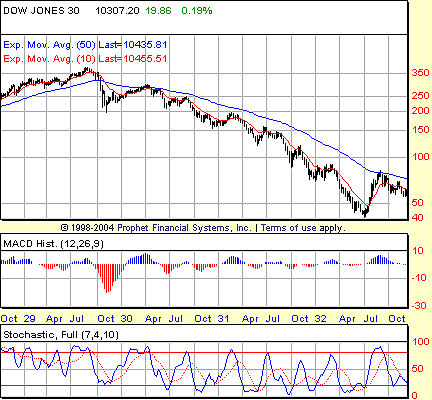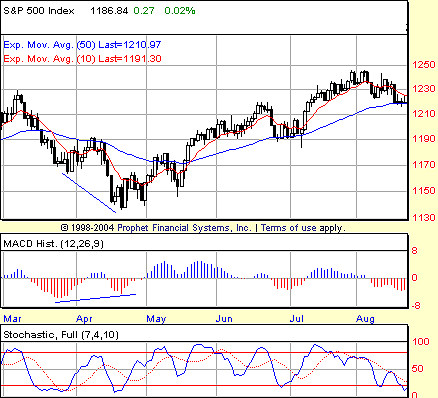
HOT TOPICS LIST
- MACD
- Fibonacci
- RSI
- Gann
- ADXR
- Stochastics
- Volume
- Triangles
- Futures
- Cycles
- Volatility
- ZIGZAG
- MESA
- Retracement
- Aroon
INDICATORS LIST
LIST OF TOPICS
PRINT THIS ARTICLE
by David Penn
MACD histogram troughs in the first half of October suggest that the market's move downward is not yet over.
Position: N/A
David Penn
Technical Writer for Technical Analysis of STOCKS & COMMODITIES magazine, Working-Money.com, and Traders.com Advantage.
PRINT THIS ARTICLE
MACD
Deeper Into October
10/18/05 08:03:05 AMby David Penn
MACD histogram troughs in the first half of October suggest that the market's move downward is not yet over.
Position: N/A
| Writing in his classic book, Trading For A Living, trader, author, and trading educator Alexander Elder makes an important but often overlooked point about the moving average convergence/divergence's (MACD) clever cousin, the MACD histogram: |
| The MACD histogram works like headlights on a car--it gives traders a glimpse of the road ahead. New highs and lows in this indicator are usually followed by new high or low prices. A record peak for the past three months in the daily MACD histogram shows that bulls are very strong and prices are likely to rise even higher. A record new low for the MACD histogram for the past three months shows that lower prices are likely ahead (Figure 1). |

|
| FIGURE 1: NEW LOW IN THE MACDH. A new low in the MACD histogram in early October hints that the lows of the first half of the month are likely to be exceeded. |
| Graphic provided by: Prophet Financial, Inc. |
| |
| In Working-Money.com articles like "Post-Breakdown MACDH Extremes" (May 19, 2004) and "Symmetrical Triangles And The MACDH" (March 24, 2004), I have echoed Elder's point about the use of the MACD histogram. In fact, I've gotten to the point at which the histogram is more important to me than the MACD! To recap, when a MACD histogram extreme is reached to the upside or downside, traders, speculators, and investors should be on guard for further price action in the direction of the extreme. This price action might come after a bounce or dip. But the fact that the MACD histogram has reached an extreme positive or negative reading--relative to recent performance--means that whichever side is controlling the market, they have not yet released the reins. This kind of technical phenomenon works on all time frames. One of my favorite examples of how effective a warning the MACD histogram can provide comes from this weekly chart of the Crash of 1929 (Figure 2): |

|
| FIGURE 2: THE MACDH AS A PREDICTOR. The resumption of the Crash of 1929 was telegraphed by the MACD histogram extreme in the fourth quarter of 1929. Even though the DJIA rebounded until the second quarter of 1930, that MACD histogram extreme warned that the worst was far from over. |
| Graphic provided by: Prophet Financial, Inc. |
| |
| Back in the present, the decline in the first half of October 2005 has been in the Standard & Poor's 500 even sharper than the August declines. In addition, relative to August, October has displayed a MACD histogram extreme to the downside that is lower than any since late March 2005. It is worth remembering that the MACD histogram extreme to the downside in March 2005 was signaling that the lows for the decline would come after and lower than the current low in March (Figure 3). True enough, the S&P 500 bottomed a month later--with a far shallower MACD histogram trough, I might add--and proceeded on a multimonth bull market. |

|
| FIGURE 3: MACDH AND THE BEARS. The deep histogram trough in late March suggested that the power in the market remained with the bears. The shallower MACD histogram trough in April was confirmation that the bearish momentum was waning, and that the bulls would have an opportunity to move the market higher. |
| Graphic provided by: Prophet Financial, Inc. |
| |
| What does this mean for traders in the autumn of 2005? Most immediately, MACD histogram trends suggest strongly that the lows in the first half of October will not be the lows for the current move down, which began in early August. While the market may be close to a significant bottom--as the market was in March of this year--that significant bottom does not appear to be here just yet. Apart from the MACD histogram, the fact that the S&P 500 broke down below the 1200 level early in the month and has been unable to bounce back above it is another bearish tell. |
Technical Writer for Technical Analysis of STOCKS & COMMODITIES magazine, Working-Money.com, and Traders.com Advantage.
| Title: | Technical Writer |
| Company: | Technical Analysis, Inc. |
| Address: | 4757 California Avenue SW |
| Seattle, WA 98116 | |
| Phone # for sales: | 206 938 0570 |
| Fax: | 206 938 1307 |
| Website: | www.Traders.com |
| E-mail address: | DPenn@traders.com |
Traders' Resource Links | |
| Charting the Stock Market: The Wyckoff Method -- Books | |
| Working-Money.com -- Online Trading Services | |
| Traders.com Advantage -- Online Trading Services | |
| Technical Analysis of Stocks & Commodities -- Publications and Newsletters | |
| Working Money, at Working-Money.com -- Publications and Newsletters | |
| Traders.com Advantage -- Publications and Newsletters | |
| Professional Traders Starter Kit -- Software | |
Click here for more information about our publications!
Comments
Date: 10/21/05Rank: 4Comment:
Date: 10/31/05Rank: 5Comment:

|

Request Information From Our Sponsors
- StockCharts.com, Inc.
- Candle Patterns
- Candlestick Charting Explained
- Intermarket Technical Analysis
- John Murphy on Chart Analysis
- John Murphy's Chart Pattern Recognition
- John Murphy's Market Message
- MurphyExplainsMarketAnalysis-Intermarket Analysis
- MurphyExplainsMarketAnalysis-Visual Analysis
- StockCharts.com
- Technical Analysis of the Financial Markets
- The Visual Investor
- VectorVest, Inc.
- Executive Premier Workshop
- One-Day Options Course
- OptionsPro
- Retirement Income Workshop
- Sure-Fire Trading Systems (VectorVest, Inc.)
- Trading as a Business Workshop
- VectorVest 7 EOD
- VectorVest 7 RealTime/IntraDay
- VectorVest AutoTester
- VectorVest Educational Services
- VectorVest OnLine
- VectorVest Options Analyzer
- VectorVest ProGraphics v6.0
- VectorVest ProTrader 7
- VectorVest RealTime Derby Tool
- VectorVest Simulator
- VectorVest Variator
- VectorVest Watchdog
